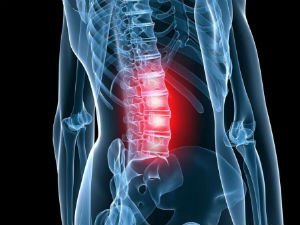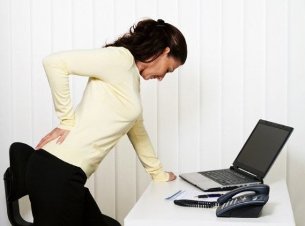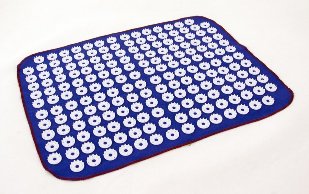
According to medical statistics, 80% of low back pain cases are due to lumbar degeneration. This occurs due to degenerative-dystrophic changes in this segment, when the disc and neighboring vertebrae are affected. Lumbar spinal cord tumors (OBOP) are manifested by many symptoms: pain of different properties, limited mobility, decreased sensitivity of the lower body, . . . Without prolonged treatment, tooThe degenerative process spreads to the vertebrae, reducing the ability to work, after which the patient can become disabled.
In order to avoid the dangerous complications of lumbar necrosis (LP), you need to start complex treatment at 1 to 2 clinical stages. In advanced cases, when there have been irreversible changes in the disc or vertebrae, a surgery will be performed. In order to avoid bone necrosis of the lower back and related complications, it is necessary to take precautions.
Development of lumbar necrosis
To understand what is lumbar degeneration (lumbar spine), you need to study the structure of the spine. It consists of vertebrae, between them are placed cartilage pads (disc). The disc is covered with an annulus fibrosus, the nucleus of which is inside. This structure has the function of absorbing shocks and makes the spine more flexible.
Help. The lumbar segment of the spine is subjected to great daily pressure, as it can bear the weight of the upper body. Therefore, lower spine bone tumors are diagnosed more often than the cervical and thoracic vertebrae.
With frequent stress on the spine, the intervertebral discs shrink, lose a lot of fluid, decrease height and spacing between vertebrae. The cartilage lining becomes fragile, small cracks appear on its surface, through which the marrow nucleus bulges out over time. As the discs are further squeezed, the outer shell breaks and the colloidal core falls out, thus forming a herniated mass. Then, there is pathological mobility of the vertebrae, the load on the adjacent segments of the spine increases.
Some time later, developed bones (osteoporosis) begin to form at the edges of the vertebral body. Thanks to that, the body tries to stabilize the spine.
Doctors distinguish 4 stages of osteoporosis of the lumbar spine:
- 1 degree - problems with the disc start, the center is dehydrated, it flakes off, cracks appear on the outer shell. There is an erased current.
- 2 degrees - cartilage sagging, vertebrae closer together, more mobile, muscles and ligaments around the spine sagging. Pain appears.
- 3 degrees - formation of protrusions, hernias and appendages of the vertebra. The pain increases, movement restriction, hypersensitivity disorder of the hypotenic region.
- Grade 4 osteonecrosis is characterized by the presence of bone-forming cells, which can damage the spinal nerves and neighboring vertebrae. Persistent pain, severe neurological disorders and other complications, and the risk of disability increases.
The simplest way to cure mycorrhea (stage 1), however, it is very difficult to identify the disease at this stage. Grade 2 disc bone tumors are treated with conservative techniques. Maybe stage 3-4 surgery is required.
Help. According to statistics, OBO is usually detected in patients after 30 years of age. There are frequent cases of the development of the pathology in people after 20 years. Approximately 80% of patients over 60 years of age develop symptoms of this disease.
Reason
To understand how to deal with PKOP, osteonecrosis (spinal cord) you need to know its cause:
- Regular static or dynamic load on the waist segment. The risk group for developing osteonecrosis includes office workers, professional athletes (weightlifters), athletes, builders, etc. v.
- Bad posture, inappropriate stretching.
- Genetic tendency, abnormal during the formation of vertebral bodies. This category includes young software - curvature of the spine, caused by pathology of the vertebral body.
- Spinal injury.
- Hormonal imbalances, metabolic disorders, endocrine gland diseases cause metabolic disorders in the lumbar segment.
- Age-related changes in your body cause disc wear.
- Osteomyelitis, osteomyelitis (purulent osteomyelitis), ankylosing spondylitis (spondylitis and joints), rheumatoid arthritis, etc. v.
An illness usually has many causes.
In addition, there are factors that provoke the development of lumbar necrosis:
- Overweight.
- Passive lifestyle, long sitting.
- Consume unhealthy foods (fatty foods, fried foods, confectionery, semi-finished products, etc. ) on a regular basis.
- Lack of fluid, dehydration.
- An innate disorder of the structure of the spine, for example, an additional vertebra.
- Wearing uncomfortable high heels often.
- During pregnancy, when the load on the spine increases.
- Suddenly refuses to train professional athletes or over-play sports in people who previously had a passive lifestyle.
- Smoking, drinking alcohol often and excessively.
There are many other factors that can trigger degenerative-dystrophy of the lumbar spine. For example, flat feet, low back temperature, frequent stress, sleep disturbances, etc. v.

Symptoms
Symptoms of lumbar spinal necrosis are diverse, they depend on the stage of the pathology and the area affected.
Doctors differentiate reflex and compression syndromes (complex of symptoms) in OBOR. The first arises when the receptors of the disc's outer membrane, ligaments, and sacrum are stimulated and the second, when bundles of nerves, blood vessels and spinal cord are compressed.
There are reflex syndromes of lumbar necrosis:
- Lumbago. Low back pain with sudden movement or exertion. When just trying to move slightly, pain syndrome increases, so the patient is frozen in one position. The muscles in the affected area are very tight, and when touched, the pain is more pronounced. These manifestations are related to the movement of the medullary nucleus within the outer shell.
- Body weakness. Pain that develops over a few hours or days. Discomfort increases with movement, body position changes. It is weakened when the person performs a horizontal position with the lower back roller. When lifting the legs straight in this position, the pain intensifies (Lassegh's symptom). Less muscle tension with lower back pain. The lower back's mobility is limited.
- Abdominal pain. Pain (sharp or aching) sensation spreading from the back to the lower body. There is an increase in this mark in movements. You will relieve pain by lying on your back. Muscles in the affected area are stressed, pain syndrome becomes evident when palpable.
The symptoms of compression syndrome depend on which part of the lumbar segment is damaged. Characteristic signs are compression of the spinal nerves by a hernia, bone tumor, and spinal dislocation. This condition is known as the etiology, in which pain increases with slight movement, muscles in the lower back are tense, and mobility is limited.
Clinical manifestations of compression syndrome depending on the damaged vertebrae of the lumbar segment:
- L1 - L3 - pain and numbness in the lumbar region, the front thighs and the inner face, the patient has difficulty bending / bending the legs at the knee.
- L4 - pain syndrome extending to the front of the thigh, down to the knee (back). In the same area, the sensitivity was disturbed.
- L5 - Pain sensation radiating to the buttocks, the outer part of the thighs, goes along the front of the shin to the inner part of the foot and big toe. In the same area that feels numb, it is difficult for patients to have their big toe shrink.
- S1 - pain spreading from lower back to buttocks, outer surface and back of thighs, down to outer part of shins, feet. At the same positions, the feeling of numbness and lower leg muscles makes it difficult for the patient to stand on tiptoes.
There is a risk of damaging several nerve bundles at once, for example, L5, S1. If the hernia moves backwards, it can compress the spinal cord.
Compression of blood vessels in the back area increases the likelihood of leg muscle weakness, numbness of the lower extremities, and impaired ability to control urination and bowel processes. In men with OBO, erection is impaired, and in women, the main symptoms may be complemented by inflammation of the ovaries or uterus.
Diagnostic measures
To diagnose OBO, the doctor examines the patient, palms the patient to determine the condition of the muscles and determines the curvature of the spine. It is important to talk to the therapist in detail about your symptoms to help make the diagnosis easier.
Instrumental examination will help detect disc bone tumors:
- X-ray of the lower back (front and rear projection).
- Magnetic resonance imaging and computation.
X-rays allow you to evaluate the structure of BPTNMT. To detect abnormal mobility of the vertebrae, take X-rays in the bent and stretching positions. This study allowed us to see that the disc fissure has narrowed, the vertebral bodies displaced, and the bone cells appeared on their edges. However, this diagnostic method is considered obsolete.
Nowadays, CT and MRI are used more and more to detect degenerative-dystrophic changes in the spine. These highly informational studies make it possible to evaluate the condition of the vertebrae, disc, disc and spinal cord. With their help, protrusions, the direction of hernias, the degree of compression of the bundles of nerves, spinal cord and blood vessels are detected.
Treatment
MEDICINE FOR THE TREATMENT OF LUMBAR VIOLENCE

EPP treatment of bone necrosis lasts from 1-3 months to 1 year. The success of therapy depends on the patient himself, who must strictly adhere to the doctor's recommendations. With self-medication, the patient's condition often worsens.
Treatment target:
- Stop or minimize software symptoms.
- Identify the cause of the disease, try to eliminate it from life.
- Eliminates the inflammatory process.
- Restore blood circulation, metabolism in the lumbar spine.
- Tries to improve the condition of the damaged cartilage lining, to prevent further degenerative changes.
To achieve such a goal, you should perform a complex therapy. It usually starts with medication:
- Muscle relaxants. They relax muscles, relieve pain and inflammation.
- NSAIDs. They have anti-inflammatory, analgesic, and antipyretic effects.
- Antispasmodic. They help relieve smooth muscle spasm, relieve pain.
- Anesthetic. They are used for severe pain syndrome in the form of therapeutic blockade.
- Glucocorticosteroid. They also help to cope with pain. However, these drugs can destroy bones, so they are taken for a short time and only after getting the permission of a doctor.
- Sedative. They reduce neuromuscular stress, improve sleep.
- Vitamins (groups B, E, C, A). Restores the condition of the affected nerves, relieves pain.
Careful. NSAIDs are prohibited for gastritis or stomach ulcers, because they further damage the mucous membranes of the digestive tract.
In the case of an exacerbation, the patient is given an injection. After reducing the main symptoms, the patient is given oral medication.
In addition, external agents (gels, ointments, creams, lotions) are used.
The question of what to do in the case of chronic backbone necrosis is quite appropriate. If the OBOP has become chronic, then after reducing the main symptoms, the patient is prescribed chondroprotectors, drugs that restore blood circulation, drugs based on vitamin B. They help restore the interior, normalize the blood supply. in the affected area and prevent further development of the pathology.
Lumbar fibrosis treatment (stage 1) is carried out using chondroprotectors, which help to slow down the development of degenerative processes, accelerate cartilage regeneration. In addition, the patient is prescribed vitamin and mineral complexes. This form of bone necrosis is the easiest to treat.
OTHER PRESERVATION TECHNIQUES
In the case of an acute chronic disease (osteonecrosis) of grades 1-2, the following procedures will help prevent the development of the disease:
- Ultrasound therapy reduces pain and inflammation, and normalizes blood flow in the affected area.
- Meteor therapy is a safe spinal traction due to the weight of each person's own body, after which muscle tone normalizes and mobility improves.
- Magnetic therapy helps relieve pain and inflammation of the muscles surrounding the spine.
- Acupressure (inserting needles into bioactive points on the body) speeds up blood circulation, reduces inflammation and edema.
- Manual therapy (acting on the affected area with the hand of the doctor) and massage normalizes muscle tone, reduces compression of nerve bundles, improves disc nutrition and restoresstructure of the spine.
- Electrophoresis allows the delivery of drug solution through the skin to bone and cartilage tissues.
- Drasonvalization improves blood circulation, metabolism, relieves pain, restores skin sensitivity.
There are more effective therapies that will improve the patient's condition in 5-15 sessions. The main thing is to get a doctor's approval before taking them.
HOME SOFTWARE TREATMENT
If you are wondering if it is possible to treat OBO at home, talk to your doctor. If approved by the specialist, then initiate therapy, usually including the following points:
- Diet. If lumbar degenerative disease is due to impaired blood flow or metabolism, fatty, fried, spicy, egg, … foods should be excluded. Supplement the menu with fresh vegetables, fruits, lean meat, fish, and dairy products. Quit alcohol, healthy drinks (tea, coffee). Drink water, filtered water, herbal tea.
- To restore blood circulation, exercise or rub and compress.
- Sleep on orthopedic mattress, low pillow. If you have a sedentary job, buy a chair with a backrest to support your spine. Wear a special bra or belt from time to time.
- Exercise therapy will help strengthen the muscles, partially reducing the load from the diseased spine. Each patient complex is individually compiled by a physician or instructor.
- Self-massage of the lumbar region. However, ask an expert how to do it right.
- Use folk remedies in the form of rubs, compresses, baths, etc. v.
- The needle prick is a spiked plastic sheet that improves blood circulation, metabolism in the affected area, relieves muscle pain, and relaxes.

In addition, at home you can use lotions and lotions.
Help. A new feature in the treatment of osteonecrosis is the massage bed that is suitable for even the most disorganized patients.
However, keep in mind that treatment can only be performed at home with the permission of a doctor.
SURGICAL TREATMENT
Lumbar resection is indicated if conservative techniques are ineffective for a long time. And surgical intervention is also indicated for cases of urination, incontinence and cauda equina syndrome (compression of the nerves of the lower spinal cord).
The following surgical methods are used in the OBO treatment:
- Spondylodesis - fusion of adjacent vertebrae.
- Chiropractic - removal of a disc joint that compresses a spinal nerve.
- Removal of the membrane is to remove the membrane covering the spinal canal that compresses the spinal cord.
- Disc ablation is the complete or partial removal of the disc causing compression of a nerve root or spinal cord.
- Removal of the cornea - removal of the vertebral body and neighboring cartilage pads. The void was then filled with a bone graft and three vertebral segments were fused.
Help. After surgery there is a risk of complications: spinal cord injury, nerve bundles, graft debris, infection, . . .
After the treatment, you need to rehabilitate to speed up the recovery.
Complications
In the absence of appropriate therapy, the risk of complications of such lumbar necrosis increases:
- Disc herniation, compression of nerve roots or spinal cord.
- Prolonged inflammation increases the likelihood of developing neuritis (neuritis).
- Sciatica (inflammation of the sciatica), in which severe pain and numbness in the lower extremities.
- In the case of impaired blood circulation in the spinal cord, the likelihood of a spinal cord compression increases (spinal compression by various morphologies: bone fragments, hernias, tumors, hematomas).
- Equina Cauda syndrome - compression of the roots of the lower spinal cord, leading to impaired function of the intestines, pelvic organs and lower extremities.
To avoid such complications, you need to start treatment as soon as possible.
Precautions
To avoid lumbar necrosis, follow these rules:
- Practice a moderate lifestyle (walk more often, exercise regularly, sign up for a swim).
- For sedentary work, warm up every 1. 5 hours.
- Sleeping on an orthopedic mattress.
- Avoid exertion, just lift the dumbbells from a half-squat position, before that, put a special belt on your lower back.
- Buy orthopedic shoes.
- Eat in moderation and take a complex vitamin and mineral supplement as directed by your doctor.
- Learn to relax.
- Do your best to avoid hypothermia.
- Promptly treat the diseases that can cause OBO.
- Get rid of bad habits.
By following these recommendations, you can avoid degenerative changes in your spine and improve your health.
Most important
If you notice symptoms of lumbar necrosis, seek immediate medical attention. Self-treatment can make the condition worse and cause complications. Lumbar fibrosis (stage 1) is treated with exercise therapy, physiotherapy, and lumbar defense drugs. In the later stages, using drugs, massage, manual therapy, . . . In case there is no motion or neurological symptoms for a long time, the doctor may prescribe surgery. The patient must strictly adhere to the doctor's recommendations to speed up recovery.





































